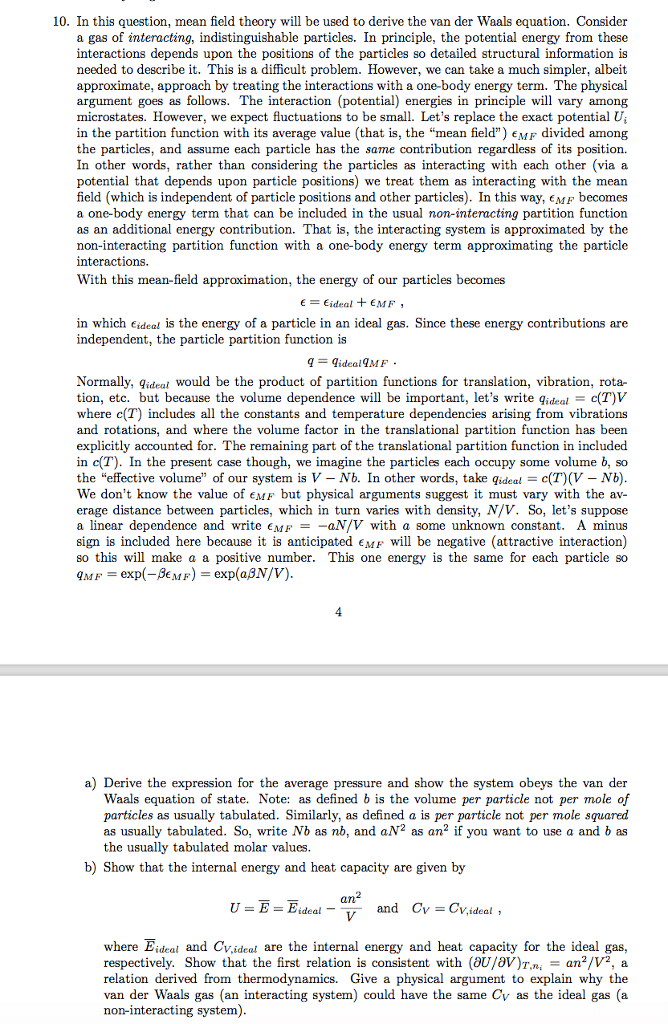this is a thermodynamics class Return to the problem of parts 1a and 1b, above. In Problem 1, we assumed there was no energy change involved in the formation of the complex AB. Now, we will look at the situation again, but consider what effects might arise from the addition of an interaction energy in the complex AB. a.) Consider the same case as in question 1d, where there are either two monomers A and B or one complex, AB, in equilibrium in a volume consisting of 106 boxes. Suppose that the interaction energy of proteins A and B in the dimer is â5 kBT. In other words, the molecular interactions that occur in the complex reduce the energy of AB by 5 times thermal energy in comparison to having two separated and non-interacting monomers. Write the canonical partition function (considering only configurational microstates) and calculate its value. Hint: There are two energy macrostates, the dimer AB, whose energy we can take to be 0, and the separated monomers, A + B, whose energy we can take to be +5 kBT. Use the formula for the canonical partition function that states: Q=â_EâãW(E)e^(-E/k_B T) ã = W(0)e^(-0) + W(5k_B T)e^(-5) where W(0) is the number of microstates for the dimer, and W(5kBT) is the number of microstate for the separated monomers. b.) In this case, what is the probability that the system is in the complex? Compare this result to the result obtained in question 1d, which is the probability of the dimer being present when there is no extra interaction energy in forming the dimer. By how big a factor does the interaction energy of â5kBT increase the likelihood of a dimer being present? c.) Suppose that the interaction energy discussed in part a were not equal to â5kBT, but could instead be some other value. At what value of the interaction energy, expressed in multiples of kBT, would the likelihood of the system being in the dimer be exactly 1/2?
this is a thermodynamics class Return to the problem of parts 1a and 1b, above. In Problem 1, we assumed there was no energy change involved in the formation of the complex AB. Now, we will look at the situation again, but consider what effects might arise from the addition of an interaction energy in the complex AB. a.) Consider the same case as in question 1d, where there are either two monomers A and B or one complex, AB, in equilibrium in a volume consisting of 106 boxes. Suppose that the interaction energy of proteins A and B in the dimer is â5 kBT. In other words, the molecular interactions that occur in the complex reduce the energy of AB by 5 times thermal energy in comparison to having two separated and non-interacting monomers. Write the canonical partition function (considering only configurational microstates) and calculate its value. Hint: There are two energy macrostates, the dimer AB, whose energy we can take to be 0, and the separated monomers, A + B, whose energy we can take to be +5 kBT. Use the formula for the canonical partition function that states: Q=â_EâãW(E)e^(-E/k_B T) ã = W(0)e^(-0) + W(5k_B T)e^(-5) where W(0) is the number of microstates for the dimer, and W(5kBT) is the number of microstate for the separated monomers. b.) In this case, what is the probability that the system is in the complex? Compare this result to the result obtained in question 1d, which is the probability of the dimer being present when there is no extra interaction energy in forming the dimer. By how big a factor does the interaction energy of â5kBT increase the likelihood of a dimer being present? c.) Suppose that the interaction energy discussed in part a were not equal to â5kBT, but could instead be some other value. At what value of the interaction energy, expressed in multiples of kBT, would the likelihood of the system being in the dimer be exactly 1/2?

